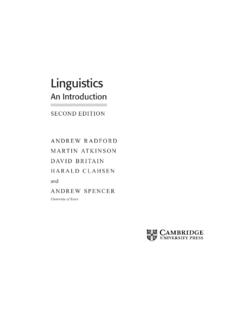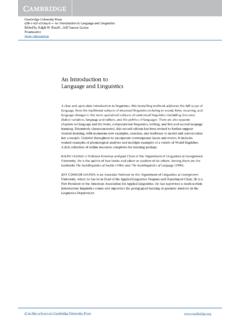Transcription of Computational Sociolinguistics: A Survey - arXiv
1 [ ] 6 Apr 2016 Computational Sociolinguistics: A SurveyDong NguyenUniversity of TwenteA. Seza Do gru zTilburg University/Netherlands Institute for AdvancedStudy in the Humanities and SocialSciences (NIAS)Carolyn P. Ros Carnegie Mellon UniversityFranciska de JongUniversity of Twente/Erasmus University RotterdamLanguage is a social phenomenon and variation is inherent toits social nature. Recently, therehas been a surge of interest within the Computational linguistics (CL) community in the socialdimension of language.
2 In this article we present a Survey ofthe emerging field of ComputationalSociolinguistics that reflects this increased interest. We aim to provide a comprehensive overviewof CL research on sociolinguistic themes, featuring topicssuch as the relation between languageand social identity, language use in social interaction andmultilingual communication. More-over, we demonstrate the potential for synergy between the research communities involved, byshowing how the large-scale data-driven methods that are widely used in CL can complementexisting sociolinguistic studies, and how sociolinguistics can inform and challenge the methodsand assumptions employed in CL studies.
3 We hope to convey thepossible benefits of a closercollaboration between the two communities and conclude with a discussion of open IntroductionScience has experienced a paradigm shift along with the increasing availability of largeamounts of digital research data (Hey, Tansley, and Tolle 2009). In addition to thetraditional focus on the description of natural phenomena,theory development andcomputational science, data-driven exploration and discovery have become a dominantingredient of many methodological frameworks.
4 In line withthese developments, thefield of Computational linguistics (CL) has also communication occurs in both verbal and nonverbal form. Research oncomputational linguistics has primarily focused on capturing the informational di-mension of language and the structure of verbal informationtransfer. In the wordsof Krishnan and Eisenstein (2015), Computational linguistics has made great progressin modeling language s informational dimension, but with afew notable exceptions,computation has had little to contribute to our understanding of language s socialdimension.
5 The recent increase in interest of Computational linguists to study languagein social contexts is partly driven by the ever increasing availability of social media from social media platforms provide a strong incentivefor innovation in the CLresearch agenda and the surge in relevant data opens up methodological possibilitiesfor studying text as social data. Textual resources, like many other language resources,can be seen as a data type that is signaling all kinds of socialphenomena. This isrelated to the fact that language is one of the instruments bywhich people constructComputational LinguisticsTo appeartheir online identity and manage their social network.
6 There are challenges as example, social media language is more colloquial and contains more linguisticvariation, such as the use of slang and dialects, than the language in datasets that havebeen commonly used in CL research ( , scientific articles, newswire text and the WallStreet Journal) (Eisenstein 2013b). However, an even greater challenge is that the relationbetween social variables and language is typically fluid andtenuous, while the CL fieldcommonly focuses on the level of literal meaning and language structure, which is tenuous connection between social variables and language arises because ofthe symbolic nature of the relation between them.
7 With the language chosen a socialidentity is signaled, which may buy a speaker1something in terms of footing within aconversation, or in other words: for speakers there is room for choice in how to usetheir linguistic repertoire in order to achieve social goals. This freedom of choice isoften referred to as the agency of speakers and the linguistic symbols chosen can bethought of as a form of social currency. Speakers may thus make use of specific wordsor stylistic elements to represent themselves in a certain way.
8 However, because of thisagency, social variables cease to have an essential connection with language use. It maybe the case, for example, that on average female speakers display certain characteris-tics in their language more frequently than their male counterparts. Nevertheless, inspecific circumstances, females may choose to de-emphasizetheir identity as femalesby modulating their language usage to sound more male. Thus,while this exceptionserves to highlight rather than challenge the commonly accepted symbolic associationbetween gender and language, it nevertheless means that it is less feasible to predicthow a female will sound in a randomly selected agency also enables creative violations of conventional language as with any violation of expectations, these creative violations communicate indi-rect meanings.
9 As these violations become conventionalized, they may be one vehicletowards language change. Thus, agency plays a role in explaining the variation inand dynamic nature of language practices, both within individual speakers and acrossspeakers. This variation is manifested at various levels ofexpression the choice oflexical elements, phonological variants, semantic alternatives and grammatical patterns and plays a central role in the phenomenon of linguistic change. The audience,demographic variables ( , gender, age), and speaker goals are among the factorsthat influence how variation is exhibited in specific contexts.
10 Agency thus increasesthe intricate complexity of language that must be captured in order to achieve a socialinterpretation of investigates the reciprocal influence ofsociety and language oneach other. Sociolinguists traditionally work with spokendata using qualitative andquantitative approaches. Surveys and ethnographic research have been the main meth-ods of data collection (Eckert 1989; Milroy and Milroy 1985;Milroy and Gordon 2003;Tagliamonte 2006; Trudgill 1974; Weinreich, Labov, and Herzog 1968).
![arXiv:0706.3639v1 [cs.AI] 25 Jun 2007](/cache/preview/4/1/3/9/3/1/4/b/thumb-4139314b93ef86b7b4c2d05ebcc88e46.jpg)

![arXiv:1301.3781v3 [cs.CL] 7 Sep 2013](/cache/preview/4/d/5/0/4/3/4/0/thumb-4d504340120163c0bdf3f4678d8d217f.jpg)
![@google.com arXiv:1609.03499v2 [cs.SD] 19 Sep 2016](/cache/preview/c/3/4/9/4/6/9/b/thumb-c349469b499107d21e221f2ac908f8b2.jpg)















